Related Research Articles
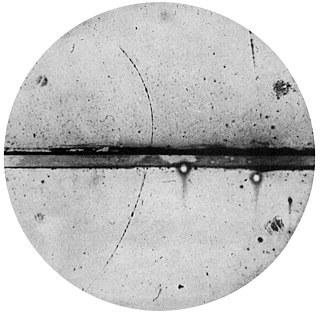
In modern physics, antimatter is defined as matter composed of the antiparticles of the corresponding particles in "ordinary" matter. Minuscule numbers of antiparticles are generated daily at particle accelerators—total artificial production has been only a few nanograms—and in natural processes like cosmic ray collisions and some types of radioactive decay, but only a tiny fraction of these have successfully been bound together in experiments to form antiatoms. No macroscopic amount of antimatter has ever been assembled due to the extreme cost and difficulty of production and handling.

The European Organization for Nuclear Research, known as CERN, is a European research organization that operates the largest particle physics laboratory in the world. Established in 1954, the organization is based in a northwest suburb of Geneva on the Franco–Swiss border and has 23 member states. Israel is the only non-European country granted full membership. CERN is an official United Nations Observer.

Carlo Rubbia is an Italian particle physicist and inventor who shared the Nobel Prize in Physics in 1984 with Simon van der Meer for work leading to the discovery of the W and Z particles at CERN.

The antiproton,
p
, is the antiparticle of the proton. Antiprotons are stable, but they are typically short-lived, since any collision with a proton will cause both particles to be annihilated in a burst of energy.
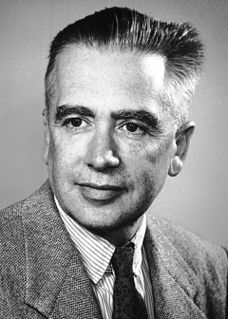
Emilio Gino Segrè was an Italian-American physicist and Nobel laureate, who discovered the elements technetium and astatine, and the antiproton, a subatomic antiparticle, for which he was awarded the Nobel Prize in Physics in 1959 along with Owen Chamberlain.

Owen Chamberlain was an American physicist who shared with Emilio Segrè the Nobel Prize in Physics for the discovery of the antiproton, a sub-atomic antiparticle.
ATHENA, also known as the AD-1 experiment, was an antimatter research project at the Antiproton Decelerator at CERN, Geneva. In August 2002, it was the first experiment to produce 50,000 low-energy antihydrogen atoms, as reported in Nature. In 2005, ATHENA was disbanded and many of the former members of the research team worked on the subsequent ALPHA experiment.
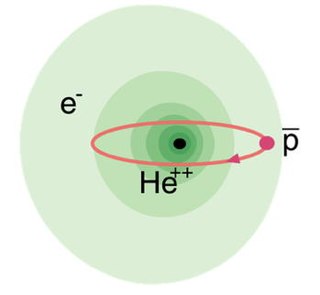
Antiprotonic helium is a three-body atom composed of an antiproton and an electron orbiting around a helium nucleus. It is thus made partly of matter, and partly of antimatter. The atom is electrically neutral, since both electrons and antiprotons each have a charge of −1, whereas helium nuclei have a charge of +2.
Gerald Gabrielse is an American physicist. He is the Board of Trustees Professor of Physics and Director of the Center for Fundamental Physics at Northwestern University, and Emeritus George Vasmer Leverett Professor of Physics at Harvard University. He is primarily known for his experiments trapping and investigating antimatter, measuring the electron g-factor, and measuring the electron electric dipole moment. He has been described as "a leader in super-precise measurements of fundamental particles and the study of anti-matter."
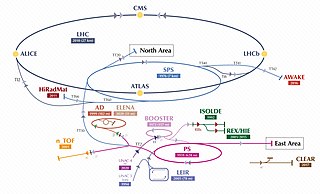
The Antiproton Decelerator (AD) is a storage ring at the CERN laboratory near Geneva. It was built from the Antiproton Collector (AC) to be a successor to the Low Energy Antiproton Ring (LEAR) and started operation in the year 2000. Antiprotons are created by impinging a proton beam from the Proton Synchrotron on a metal target. The AD decelerates the resultant antiprotons to an energy of 5.3 MeV, which are then ejected to one of several connected experiments.
Atomic Spectroscopy and Collisions Using Slow Antiprotons (ASACUSA), AD-3, is an experiment at the Antiproton Decelerator (AD) at CERN. The experiment was proposed in 1997, started collecting data in 2002 by using the antiprotons beams from the AD, and will continue in future under the AD and ELENA decelerator facility.

Alan Astbury (1934–2014) was a Canadian physicist, emeritus professor at the University of Victoria, and director of the Tri-Universities Meson Facility (TRIUMF) laboratory.

David George Charlton is Professor of Particle Physics in the School of Physics and Astronomy at the University of Birmingham, UK. From 2013 to 2017, he served as Spokesperson of the ATLAS experiment at the Large Hadron Collider at CERN. Prior to becoming Spokesperson, he was Deputy Spokesperson for four years, and before that Physics Coordinator of ATLAS in the run-up to the start of collision data-taking.
Peter Ignaz Paul Kalmus, is a British particle physicist, and emeritus professor of physics at Queen Mary, University of London.
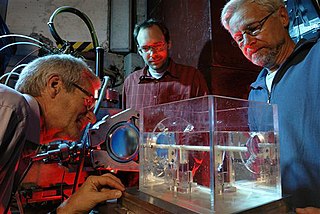
The Antiproton Cell Experiment (ACE), AD-4, at the Antiproton Decelerator facility at CERN, Geneva, was started in 2003. It aims to assess fully the effectiveness and suitability of antiprotons for cancer therapy.

The Antihydrogen Laser Physics Apparatus (ALPHA), also known as AD-5, is an experiment at the Antiproton Decelerator at CERN, designed to trap neutral antihydrogen in a magnetic trap, and conduct experiments on them. The ultimate goal of this experiment is to test CPT symmetry through comparison of the atomic spectra of hydrogen and antihydrogen. The ALPHA collaboration consists of some former members of the ATHENA collaboration or AD-1 experiment, as well as a number of new members.
AEgIS, AD-6, is an experiment at the Antiproton Decelerator facility at CERN. Its primary goal is to measure directly the effect of Earth's gravitational field on antihydrogen atoms with significant precision. Indirect bounds that assume the validity of, for example, the universality of free fall, the Weak Equivalence Principle or CPT symmetry also in the case of antimatter constrain an anomalous gravitational behavior to a level where only precision measurements can provide answers. Vice versa, antimatter experiments with sufficient precision are essential to validate these fundamental assumptions. AEgIS was originally proposed in 2007. Construction of the main apparatus was completed in 2012. Since 2014, two laser systems with tunable wavelengths and synchronized to the nanosecond for specific atomic excitation have been successfully commissioned.

BASE, AD-8, is a multinational collaboration at the Antiproton Decelerator facility at CERN, Geneva. The goal of the Japanese and German BASE collaboration are high-precision investigations of the fundamental properties of the antiproton, namely the charge-to-mass ratio and the magnetic moment.
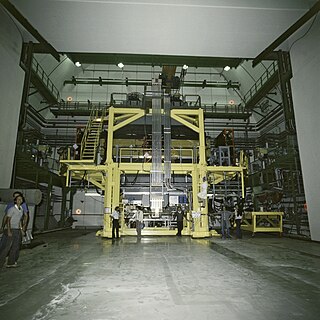
The UA5 experiment was the first experiment conducted at the Proton-Antiproton Collider, a collider using the infrastructure of the Super Proton Synchrotron (SPS). The experiment was approved in February 1979, as a collaboration between CERN and the universities of Bonn, Brussels, Cambridge and Stockholm. The spokesperson of the UA5 collaboration was John Rushbrooke.
Alexandre Obertelli is a French experimental nuclear physicist and Alexander von Humboldt Professor of Experimental Nuclear Structure Physics at the Institute of Nuclear Physics of the Technische Universität Darmstadt.
References
- ↑ Michael H. Holzscheiter
- ↑ Visiting professor: Michael Holzscheiter, 18 June 2013